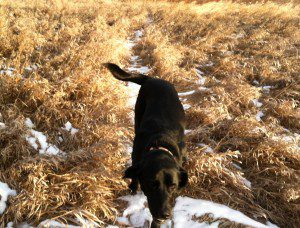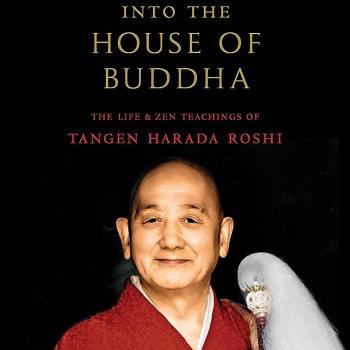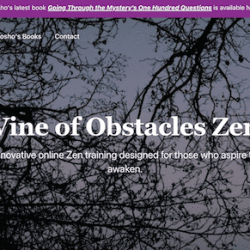 Here’s the Bodhi dog asking “What is it?” in his 100% doggie way.
Here’s the Bodhi dog asking “What is it?” in his 100% doggie way.
By the way, the talks from the Boundless Way Rohatsu 2011 are now up here (encouragement talks are listed first and then the talks by the teachers – Melissa Blacker gave the first teisho, David Rynick the second, Dosho the third, and we all chimed in on the fourth – probably our best collaboration to date imho).
The theme for the sesshin was Xuefeng’s “What is it?” (Blue Cliff 51 and Book of Serenity 50):
When Xuefeng was living in a hermitage, two monks came to pay their respects. When he saw them coming, Xuefeng thrust open the gate of his hermitage and jumped out, asking, “What is it?”
One of the monks also said, “What is it?” Xuefeng hung his head and went back inside.
The koan goes on to deal with the last word of Zen but that’s not what I’m interested in today so I’ll ignore that part for now.
I also got an email notice recently from a San Francisco Zen priest, Dairyu Michael Wenger, in part about his book, 49 Fingers. Check out his blog with a really nice “What is it?” painting here. Michael describes 49 Fingers as “…a collection of 49 American Koans, written in traditional case, commentary, verse format alongside 22 of my original brush works.”
“Case 47: What is it?” is a great scene that’s been kicked around a lot so you probably have seen it but in case you haven’t I copy it here:
When Seung Sahn (1927-2004) met Kalu Rinpoche, they were seated at a table. Seung Sahn pointed to an orange and said, “what is it?” Rinpoche did not respond. Sahn Sunim repeated, “What is it?” Rinpoche turned to his attendant and asked, “Don’t they have oranges in Korea?”
I heard this story some time ago, perhaps embellished, with the wild Korean monk picking up the orange and shoving it in the refined Tibetan master’s face, shouting repeatedly “What is it?” I bust my gut laughing at Kalu’s fresh presentation.
Michael’s refined version works too, of course.
I’d like to make just two unrefined points now. First, when it comes to “What is it?” who gets to say? And second, what “What is it?” isn’t.
Who gets to say? is a tough issue. Soto priests without koan training comment on koans regularly (including myself in my nefarious past). Koan Zen teachers without direct training in Dogen’s teachings speak definitively about Dogen. I’ve heard a well-known Vipassana teacher go on and on (and way off) about Mu.
And this isn’t limited to the dharma whirl. Nobel laureates famously develop a halo effect and have been known to talk about areas (like racial genetics) that are far from their specialty. And we are suspicious for good reason.
I’m of the school of thought that thinks that it’s best to be really careful when importing something from another tradition and imputing meaning based on our training and background to it – because we might well miss the point. Rumi, for example, coming from his Islamic/Sufi background, may well have had a depth of meaning, an angle on truth, that we modern Zennies cannot fathom.
So at least qualifying our comments are in order, “From my shikantaza training, here’s what I think this koan is about,” for example. For listeners, it’s best to assume that such qualification is always implicit.
Now that I’ve done some koan training, I confess to this hubris in my own past and from my current perspective would like to encourage my Soto non-koan trained friends to consider the possibility that there might well be something in a koan that they have not seen from their shikantaza perspective.
I suppose that goes for all of us all the time.
I recently saw a comment on another blog saying that Zen (“What is it?” in this case) is whatever each of us say that it is. That’s fine and dandy (and willy-nilly), of course, but it ignores the many practitioners in the past who really put their butts on the line to go beyond their own personal feelings about what Zen is and isn’t and just might have discovered something beyond relative pluralism.
In addition, and most importantly, by not engaging in the question (“What is it?”) with someone else with an open heart, we miss the opportunity to hear something like “Well, there’s a better answer.”
And then dig deeper into the issue at hand.
That’s the point, you see. It’s not about authority but about discovering the healing point of Zen, as Dogen put it.
Koan Zen is likewise incredibly practical. The usual drool about what Zen is and isn’t, is often just too mushy and spacey (in the guise of spaciousness) to bring home the bacon.
So although “What is it?” is a question that can be asked forever, there is also a clear and powerful response that can be actualized while walking the dog or chewing the fat. And although “I don’t know,” what Michael nicely calls “straightforward puzzlement” might close the gap, it might well not be clear or powerful or compassionate enough to bark up the right tree.
So when you hear, “What is it?” and think that you don’t know, you might not be so sure about that.
Your thoughts welcome.












